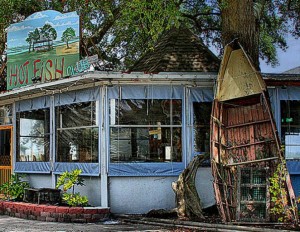 The Hot Fish Club in Murrells Inlet, SC , about 20 minutes north of DeBordieu, is known for it’s relaxed waterfront, low country dining, featuring fresh seafood and fine aged hand-cut Midwestern beef. It’s also known for the HOTTEST entertainment in the Georgetown, Pawleys Island and Murrells Inlet areas! A wide variety of musicians and bands ranging from reggae to classic rock and everything in between play nightly in the gazebo. It’s the place to go when you feel like dancing!
The Hot Fish Club in Murrells Inlet, SC , about 20 minutes north of DeBordieu, is known for it’s relaxed waterfront, low country dining, featuring fresh seafood and fine aged hand-cut Midwestern beef. It’s also known for the HOTTEST entertainment in the Georgetown, Pawleys Island and Murrells Inlet areas! A wide variety of musicians and bands ranging from reggae to classic rock and everything in between play nightly in the gazebo. It’s the place to go when you feel like dancing!
But very few folks know the history of the the “Hot and Hot Fish Club.” Today’s Coastal SC Homes guest blogger, Kimberly Duncan, wrote this slice of local history for the LOWCOUNTRY COMPANION, a publication no local or visitor be without. It’s a complete guide to everything worth knowing about in the Pawleys Island area. For more information, CLICK HERE to visit the Lowcountry Companion website.
The Hot and Hot Fish Club
By Kimberly Duncan
In the seventeenth and eighteenth centuries, wealthy Lowcountry rice planters disposed of the enviable incomes with secondary homes, expanded land holdings and distinguished educations for their offspring. They enjoyed an abundance of leisure time, too, which they spent traveling, collecting fine wines, hunting … and socializing at the Hot and Hot Fish club.
Established sometime before the War of 1812, the sole purpose of the Hot and Hot was social interaction among a group of successful, ambitious and fun-loving friends. The club did not have a written list of policies until 1845. In 1860, members of the Hot and Hot decided to publish a social history of the club, thus the Rules and History of the Hot and Hot Fish Club came into being. This booklet contains a preface of musings from former SC Governor R.F.W. Allston – one of the club’s oldest members – along with sixteen rules and a distinguished membership roster including many of the period’s most prominent names: Col. Joshua John Ward, John LaBruce, Dr. Henry M. Tucker, Joseph Alston, Jr., Dr. Allard B. and Arthur Flagg and many others.
The name for the Hot and Hot Fish Club was derived from the two separate courses of fresh, hot fish that were served at monthly meetings, thus “hot and hot.” According to the rule book, members met at or around noon “each Friday from the first Friday in June, to the last Friday, but one, in October” when planters could take time away from their crops. The club initially met in a clubhouse on DrunkenJackIsland, a small scrubby patch of land in Murrells Inlet near today’s Huntington BeachState Park. Some say the island was named for a pirate abandoned there (with several kegs of rum for comfort) by his captain – the infamous Edward Teach – better know as Blackbeard. Others believe the island was named for John “Jack” Green, an original club member who could “eat a peck of fish at a meal … and drink a quart of brandy.”
When the clubhouse on Drunken Jack Island was irreparably damaged by a storm, a new structure was build on the mainland “on the clam bank at Major
Ward’s salt vats,” in what is currently Huntington BeachState Park. Other sites were used through the years until a ten-acre land grant for a parcel on Midway seashore was obtained from Col. T. Pinckney Alston around 1860. A comfortable two room house was constructed there, complete with an adjoining bowling alley. The house featured a “good chimney” and a “substantial kitchen,” as well as “a billiard table and its appurtenances.” It was at this house that club rules were framed and adopted, requisite member signatures were obtained and a $50 fee (a significant sum in 1860!) was established.
R.F.W. Allston’s rule book preface includes colorful verbal sketches of parish residents and club members and provides valuable information about the Club.
The following is an abbreviated excerpt from his writings: My earliest knowledge of the Hot and Hot Fish Club was when, as a boy of fifteen, I went occasionally to the upper beach on a visit to my excellent and very dear sister (Elizabeth) Mrs. Tucker. Mr. John H. Tucker, a keen and successful sportsman all his life, was as ready for the fishing, when the day came round, as for a deer drive. There was no one, not even ‘big uncle,’ Jack Green, to surpass him in deep-water fishing. I was always glad when my visit to him home included a club-day. I had a place and line in his boat, and contributed, according to my own estimation, in no mean degree, to its success … The other gentlemen, with only an occasional exception, dropped their anchors in the creeks, or a little further removed from the inlet – their object being sheep-head, and the varieties of pan-fish, in all which the Club dinner abounded. There was but one salt dish (beef or ham) and one of fresh meat (generally game) on the table, and these were furnished, together with rice, by rule, in turns. For the rest, every member caught his own dinner and enough for his boat hands, each contributing some kind of bread, and such condiments as he liked … At one o’clock the President repaired to his post, and raised a flag to call in the boats; the fish taken by each boat was surveyed, and each variety in turn duly discussed … Certain hands from each boat being detailed to clean these fish, (the rule was, after scaling, to wash the fish in three waters, the last to be fresh,) the boats dropped off into the stream, within two or three hundred yards, and recommenced fishing, coming in one by one to fetch whatever was choice, during dinner. Thus, not infrequently, the best of the fish came last, and there were not wanting several at table whose experienced palates taught them to reserve a vacant place for the fish coming in second course, ‘hot and hot.’
Some of the rules of the Hot and Hot were as follows: New members were nominated by the president and elected by a majority. For each meeting, members were required to contribute one “substantial dish for dinner, one bottle of wine … and not less than two forks, two tumblers, two wine glasses, two plates and one dish.” Individuals took turns providing sugar for the Club’s use.
Unmarried members were “permitted” to furnish a “pudding, in lieu of” the substantial dish requirement. Any member who announced an engagement was “complimented” by other unmarried members with a basket of champagne. Any member who became the parent of twins furnished a basket of champagne to the Club, as did any member who was elected or appointed to a distinguished state office. A “contingent fund” was established to which each member paid $5 on the second Friday in June.
All members, “in rotation, and in order of residences,” assumed the role of president. The president was responsible for furnishing a ham and rice and for making certain dinner was prepared and on the table by 2 PM, “or not later than half past two.” Along with the vice-president, the president chose sides for playing games. Absence did not relieve the president of his ham and rice requirement; by rule, he sent it along even if he could not attend.
The vice-president brought, along with his own supper and wine, water and ice for the other club members. He also attended to the games and announced whether or not champagne would be brought to the next meeting. In the president’s absence, he presided over the meeting and had his next neighbor officiate for him.
It is unfortunate we cannot wrestle clearer, more colorful details from times gone by. Like much social history, many of the facts can only be theorized; the gaps are necessarily filled in by imagination.
Next time you are strolling Huntington’s long, blond beach, gaze northward and try to single out Drunken Jack Island. Visualize fishing boats peppering the surrounding waters. Listen for the sounds of fish flopping on wooden decks, men laughing and fresh catch frying. How fascinating the conversations and camaraderie of those powerful men would be today!
